Your Apple Watch uses multiple security layers to protect payments, including tokenization that replaces your real card numbers with unique device-specific tokens, AES-256 encryption for all payment data, and biometric authentication through wrist detection. You’ll need to double-click the side button for transactions, and if your watch is lost, Activation Lock prevents unauthorized use while Find My helps locate it. Understanding these extensive security features will help you maximize your payment protection.
Setting Up Apple Pay on Your Apple Watch
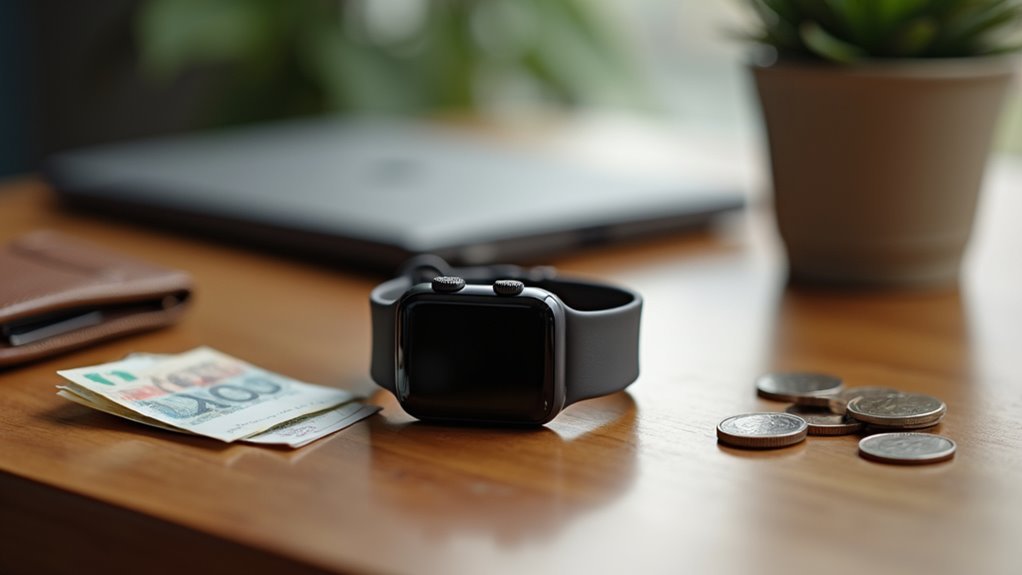
Setting up Apple Pay on your Apple Watch transforms your wrist into a secure payment terminal that works independently of your iPhone.
You’ll have two setup options: through your iPhone’s Apple Watch app or directly on your watch.
For iPhone setup, open the Apple Watch app, navigate to “My Watch,” then “Wallet & Apple Pay.” Tap “Add Card” for new cards or “Add” next to existing ones, following the onscreen instructions.
Alternatively, open your watch’s Wallet app, tap the “+” icon, select “Add Card,” and choose your card type.
Input or scan your card details and verify with your issuer. Your first added card automatically becomes your default payment method, though you can change this later through either device. After adding multiple cards, you can touch and hold any card in the Wallet app to reorder them for easier access during transactions.
Authentication Methods for Secure Transactions
Your Apple Watch offers multiple authentication layers to protect your payment transactions from unauthorized access.
You’ll rely on biometric authentication and device passcodes as your primary security methods, ensuring only you can authorize purchases.
The watch’s wrist detection feature adds another security layer by automatically locking your device when it’s removed from your wrist.
For quick payments with an unlocked Apple Watch, you can double-click the side button to instantly authorize transactions without additional authentication steps.
Biometric and Passcode Options
Apple Watch offers multiple authentication methods that balance security with convenience for your payment transactions. You can use biometric authentication like Face ID or Touch ID, depending on your paired iPhone or iPad.
Face ID uses facial recognition technology, while Touch ID relies on fingerprint scanning for secure verification.
If you prefer, you’ll also have the option to use a numeric passcode that you can set up through the Apple Watch app. This passcode works alongside biometric methods for enhanced security and can lock your device to prevent unauthorized access. To add payment cards, you’ll need to open the Apple Watch app on your paired iPhone and navigate to the Wallet & Apple Pay section.
For quick transactions, you can simply double-click your Apple Watch’s side button when the device is open, enabling fast and secure payments without opening the Wallet app.
Wrist Detection Security
Beyond these authentication options, wrist detection serves as another layer of security for your Apple Watch payments. This feature automatically secures your watch when you remove it from your wrist, preventing unauthorized access to Apple Pay and other secure functions.
When wrist detection is enabled, you’ll only need to enter your passcode once when putting on your watch. It’ll remain accessible for seamless Apple Pay transactions as long as you’re wearing it.
However, if you disable this feature, you’ll need to enter your passcode every time you make a payment. Without a passcode enabled, your Apple Pay functionality will be completely restricted.
While wrist detection doesn’t use biometric profiling to recognize you specifically, it greatly reduces security risks by ensuring your watch locks immediately when removed from your wrist.
How Tokenization Protects Your Card Information
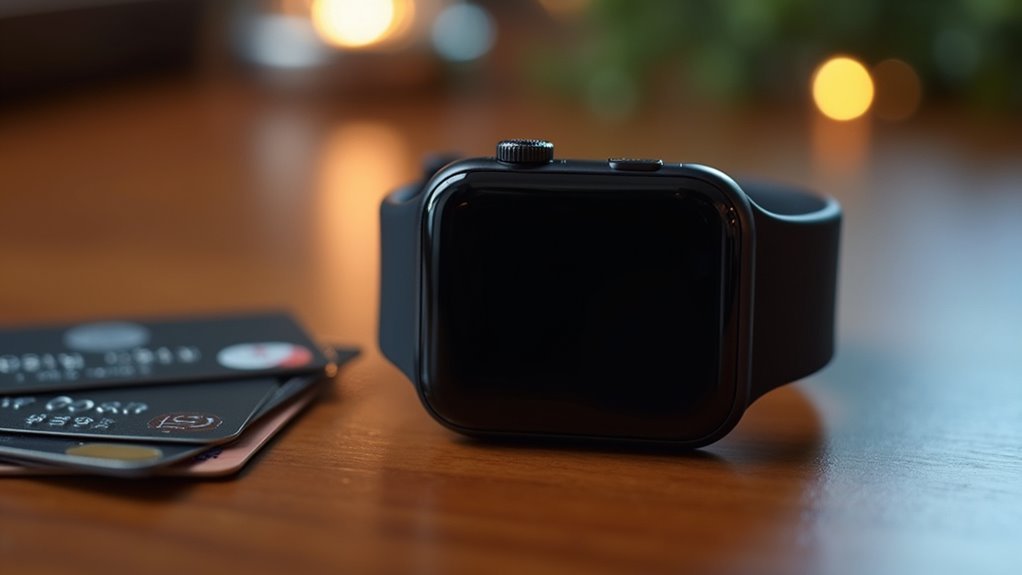
When you make a payment with your Apple Watch, tokenization guarantees your actual card number never leaves the safety of your device. Instead, your watch uses a random token that acts as a stand-in for your sensitive card information.
Here’s how it works: when you add a card to Apple Wallet, your card details trigger a tokenization request sent to your payment network and issuer. After validating your identity, they generate a unique token that’s securely delivered to your watch’s Secure Element.
This token only works on your specific device and can’t be used elsewhere. Even if intercepted, it’s useless without your watch’s cryptographic key.
Each transaction uses this tokenized data instead of your real card number, keeping your financial information completely protected. This enhanced security results in higher approval rates since banks are more likely to approve transactions that use tokenized payment methods.
Encryption and Privacy Features During Payments
While your Apple Watch handles tokenized payment data, multiple layers of encryption work simultaneously to protect your transaction from start to finish.
Your device uses AES-256-GCM and ChaCha20-Poly1305 encryption for secure communication, while Bluetooth Low Energy adds another encryption layer.
Multiple encryption protocols including AES-256-GCM and ChaCha20-Poly1305 create layered security barriers protecting your payment communications through Bluetooth Low Energy.
The Secure Element encrypts your payment data using Elliptic Curve Cryptography or RSA encryption before transmission.
Your privacy stays protected through anonymized transaction data that prevents Apple from identifying specific purchases.
The system rotates your Bluetooth device addresses every 15 minutes, reducing tracking risks.
When you authenticate with biometrics or your passcode, the Secure Enclave verifies your payment intent. Apple Pay requires a passcode entry when your device is locked for additional security verification.
Apple Pay servers then reencrypt your transaction data with merchant-specific keys, ensuring end-to-end protection throughout the entire payment process.
Two-Factor Authentication for Added Card Security
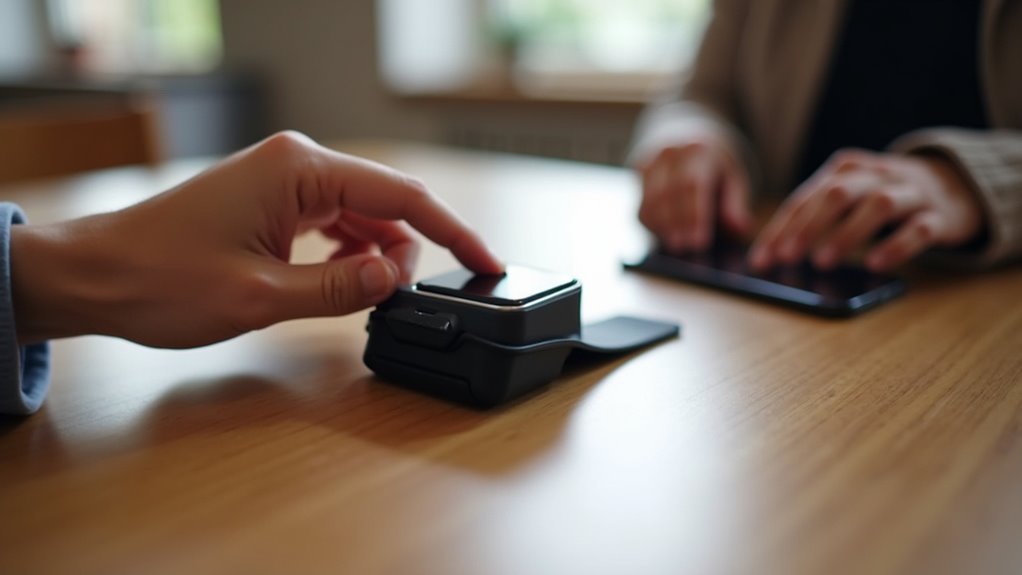
Apple adds another powerful security layer to your payment protection through two-factor authentication (2FA), which guards the Apple Account that underpins your entire Apple Pay system. When you enable 2FA, you’ll receive verification codes via text, call, or directly on your Apple Watch running watchOS 6 or later.
| Feature | Benefit |
|---|---|
| Apple Watch Code Display | Seamless verification without phone access |
| Trusted Device Integration | Auto-display codes during sign-in attempts |
| Apple Pay Protection | Safeguards account controlling payment functionality |
| Third-Party App Support | Apps like Duo Mobile generate codes on-watch |
Your Apple Watch won’t interrupt Apple Pay transactions, but it’ll strengthen your account security. You can manage 2FA settings through Settings > [Your Name] > Sign-in & Security, adding trusted numbers or updating security information as needed. Two-factor authentication serves as the default security method for most Apple accounts, providing comprehensive protection for your digital payment ecosystem.
Protection Features When Your Watch Is Lost or Stolen
Though losing your Apple Watch can feel devastating, Apple’s built-in security features work immediately to protect both your device and payment information.
Apple’s sophisticated security systems activate instantly when your watch goes missing, safeguarding your personal data and financial details from unauthorized access.
Activation Lock automatically prevents unauthorized use, requiring your Apple Account credentials to unpair or reactivate the watch with any iPhone.
Here’s how Apple protects your watch when it’s lost or stolen:
- Find My App Tracking – Your watch shows its approximate location using GPS, cellular connections, or trusted Wi-Fi networks.
- Remote Locking – You can lock your device from iCloud or your paired iPhone to prevent unauthorized access.
- Secure Erase Protection – Even after remote erasure, Activation Lock remains active and prevents reactivation.
- Continuous Lost Mode – Provides ongoing location updates while protecting your personal data and payment information. You can also display a custom message with your contact information to help someone return your watch if they find it.
Compatible Cards and Payment Terminal Requirements
When setting up payments on your Apple Watch, you’ll need compatible cards and access to NFC-enabled terminals to complete transactions.
Your watch supports debit, credit, prepaid, and transit cards from participating banks in Apple Pay networks. You can add cards through the Wallet app on your watch or via the Apple Watch app on your paired iPhone. Many cards already in your iPhone’s wallet transfer easily to your watch.
For payments, terminals must support contactless NFC technology. Most modern retail stores and transit systems accept Apple Watch payments through their existing Apple Pay-enabled terminals. The Asia-Pacific region features extensive participating bank networks that enable seamless Apple Watch transactions across diverse financial institutions.
Merchants don’t need special agreements beyond standard Apple Pay compatibility. You’ll double-click your watch’s side button and hold it near the terminal to complete secure transactions.
Frequently Asked Questions
Can I Use Apple Pay on Apple Watch Without an Internet Connection?
Yes, you can use Apple Pay on your Apple Watch without internet for in-store purchases. NFC technology enables offline transactions, but you’ll need internet for initial setup and online purchases.
What Happens to Pending Transactions if My Apple Watch Battery Dies?
Your pending transactions won’t be affected if your Apple Watch battery dies. They’re processed on Apple’s servers, not locally. Once you recharge your Watch and reconnect, pending transactions should complete normally.
Are There Daily Spending Limits When Using Apple Pay on Apple Watch?
You won’t face specific daily spending limits when using Apple Pay on your Apple Watch. However, some merchants may impose their own contactless transaction limits, and payments over $100 typically require additional authorization.
Can I Dispute Fraudulent Charges Made Through My Apple Watch Payments?
Yes, you can dispute fraudulent Apple Watch charges through your linked payment card provider. You’ll need to report the issue via your Wallet app or banking statement and provide transaction details to support your claim.
Will Apple Pay Work if My Linked Iphone Is Turned Off?
Yes, you can use Apple Pay on your Apple Watch even when your iPhone’s turned off. Your watch stores payment credentials independently and processes contactless transactions through NFC without requiring your iPhone’s power.
In Summary
You’ve got multiple layers of security protecting your Apple Watch payments. Your card numbers stay hidden through tokenization, while encryption safeguards every transaction. You’ll authenticate with your wrist detection or passcode, and two-factor authentication adds extra protection. If you lose your watch, remote wipe features keep your information safe. With compatible cards and terminals, you’re set for secure, convenient payments that protect your financial data better than traditional cards.

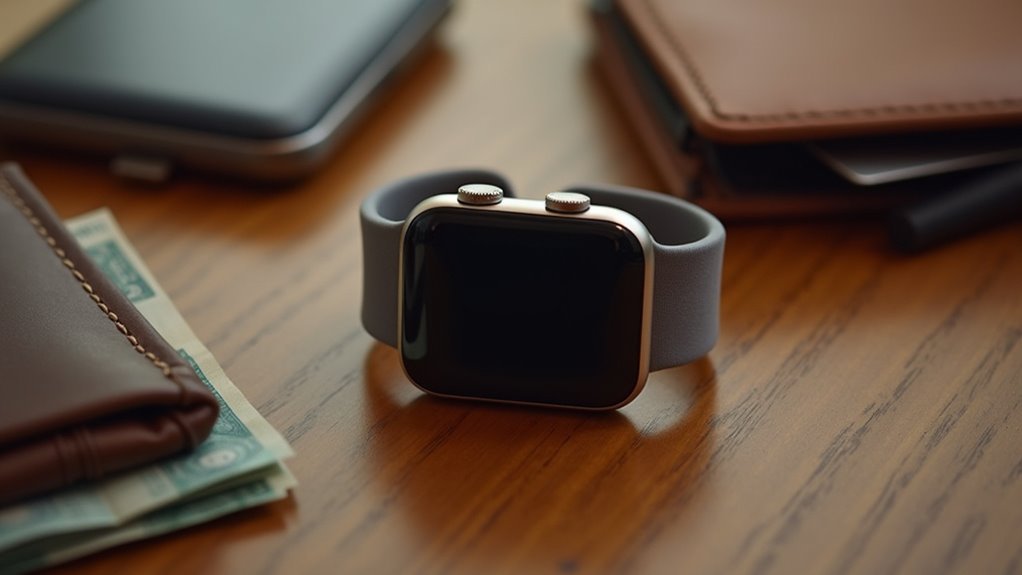

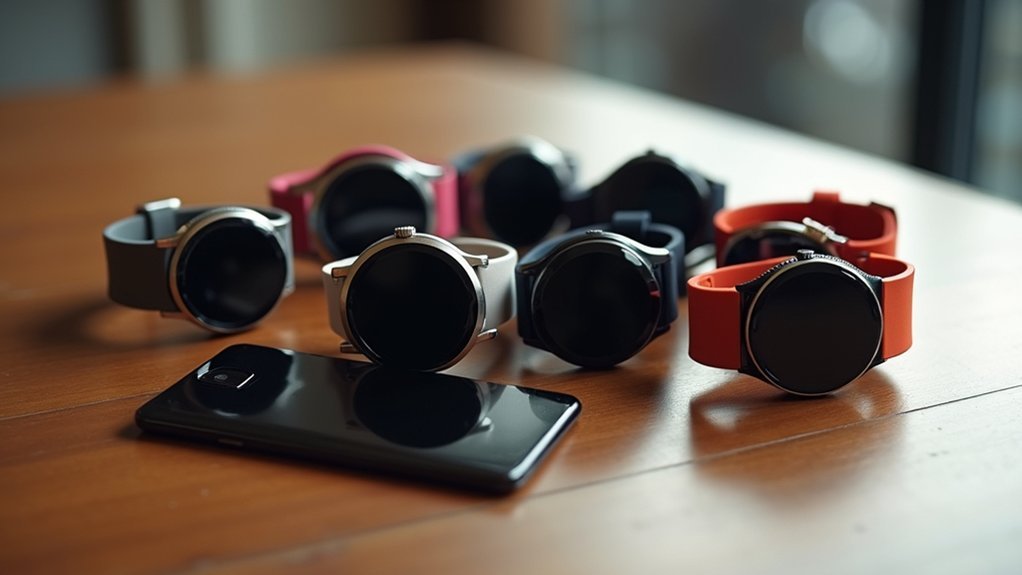
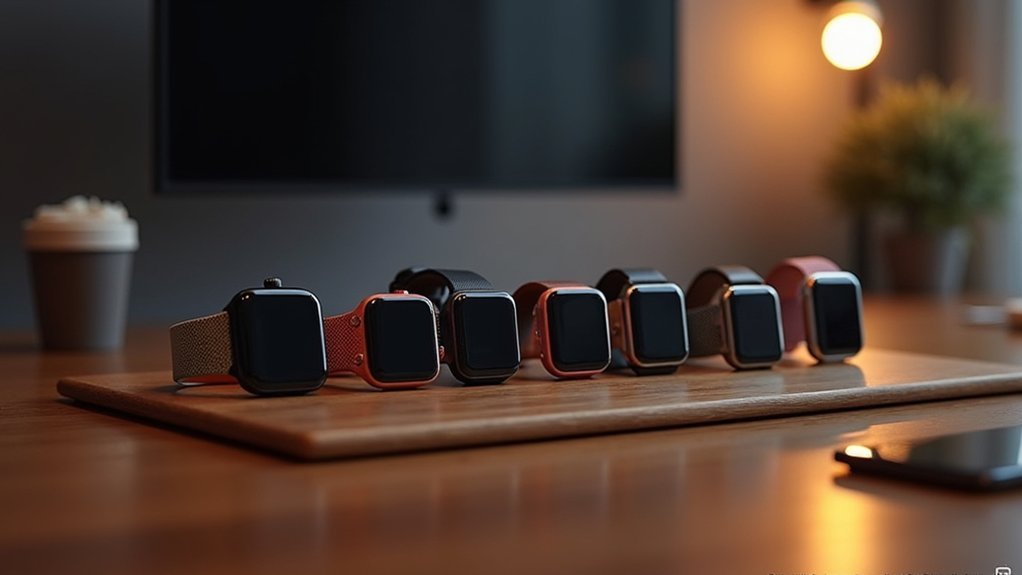
Leave a Reply